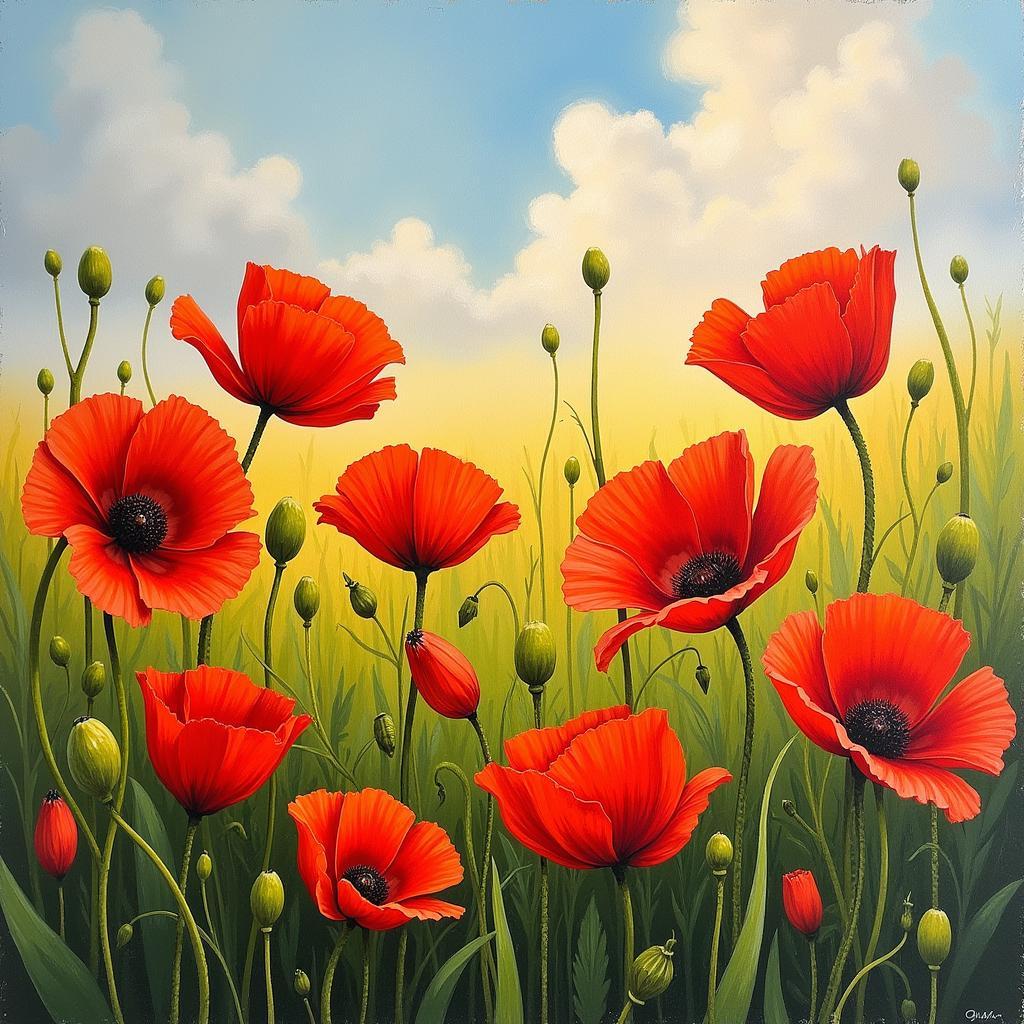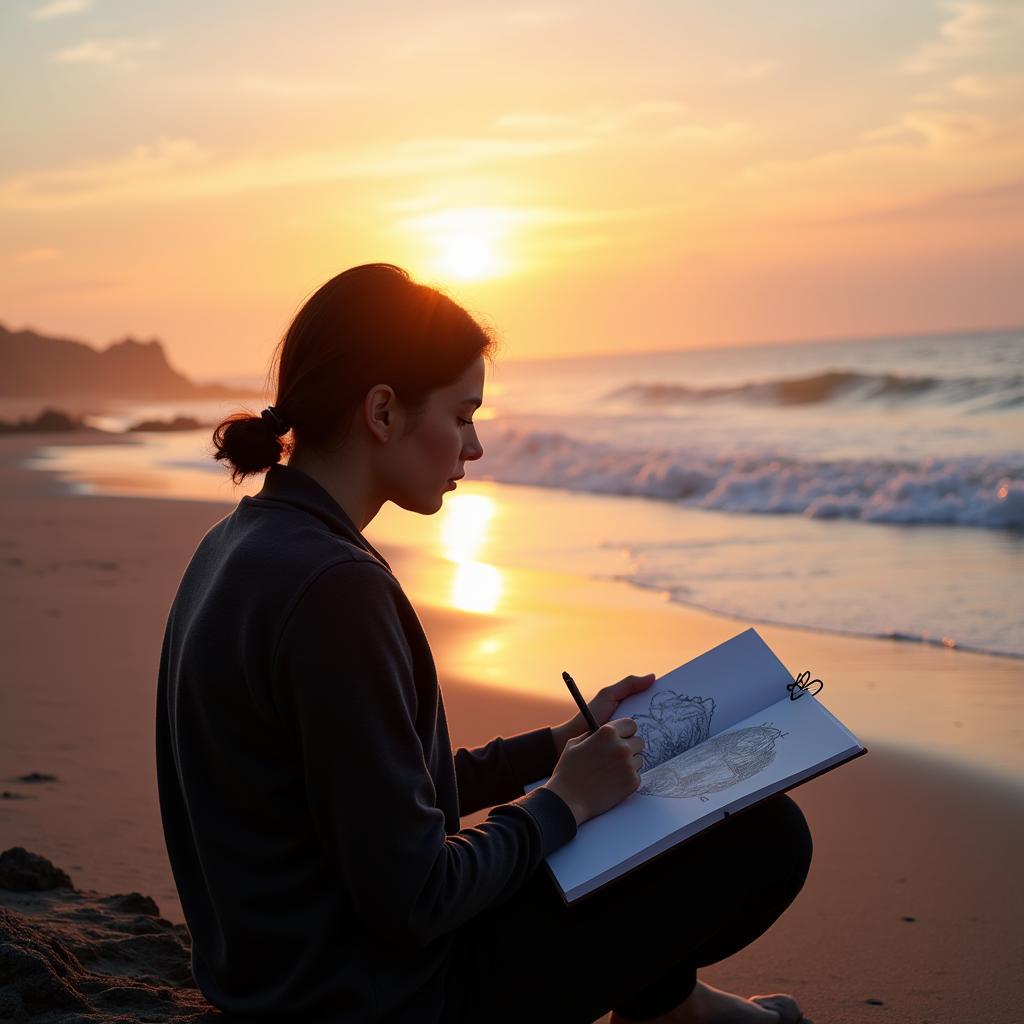Mastering Landscape Art with Oil Paints
The world of art offers countless avenues for creative expression, and landscape art in oil stands as a timeless and captivating choice. From the lush greenery of forests to the serene tranquility of seascapes, “Landscape Art Oil” encompasses a vast spectrum of subjects, each offering unique challenges and rewards for the artist. This article delves into the intricacies of this art form, providing insights, techniques, and inspiration to help you embark on your own creative journey with oil paints.
 Oil Painting of Mountains and a Lake
Oil Painting of Mountains and a Lake
Getting Started: Essential Tools and Techniques
Before diving into the world of landscape oil painting, it’s crucial to equip yourself with the right tools and a fundamental understanding of the techniques involved.
Essential Materials for Oil Painting
- Oil Paints: A curated selection of oil paints in primary colors, along with a few additional hues like burnt sienna, yellow ochre, and cerulean blue, will provide a solid foundation for mixing a wide range of colors.
- Brushes: Invest in a variety of brushes, including round, flat, and filbert shapes, in various sizes to achieve different brushstrokes and effects.
- Palette: A palette is essential for mixing and blending your oil paints.
- Palette Knife: A palette knife is a versatile tool for mixing colors, applying thick layers of paint, and creating textured effects.
- Painting Surface: Canvas, wood panels, and linen are popular choices for oil painting.
- Solvents and Mediums: Solvents like turpentine or mineral spirits thin the paint and clean brushes, while mediums like linseed oil modify the paint’s drying time, consistency, and finish.
- Easel: An easel provides a stable and adjustable platform for your painting surface.
Foundational Techniques for Landscape Oil Painting
- Layering: Oil painting thrives on layering. Begin with thin washes of paint, gradually building up the intensity and detail with subsequent layers.
- Blending: Seamlessly blending colors is key to creating realistic transitions in landscapes. Use soft brushes and gentle strokes to blend adjacent colors while the paint is still wet.
- Glazing: Glazing involves applying thin, translucent layers of paint over dried layers to modify colors, enhance depth, and create luminous effects.
Capturing the Essence of Nature: Composition and Perspective
A successful landscape painting goes beyond mere representation; it captures the essence and atmosphere of the scene.
Composition Techniques for Landscape Art
- Rule of Thirds: Divide your canvas into thirds both horizontally and vertically. Place key elements along these lines or at their intersections to create a balanced and visually appealing composition.
- Leading Lines: Utilize elements like rivers, paths, or fences to draw the viewer’s eye into the painting and create a sense of depth.
- Framing: Use natural elements like trees or archways to frame the focal point of your painting and create a sense of enclosure.
Mastering Perspective in Landscape Painting
- Linear Perspective: Use converging lines and vanishing points to create the illusion of depth and distance.
- Atmospheric Perspective: Objects in the distance appear lighter, less detailed, and bluer due to the scattering of light in the atmosphere.
- Color Perspective: Warm colors tend to advance, while cool colors recede, creating a sense of depth and dimension.
Finding Your Style: From Realism to Impressionism
Landscape art oil painting encompasses a spectrum of styles, each with its own unique approach to depicting the natural world.
Realism: Capturing Every Detail
Realism in landscape painting strives for a faithful and detailed representation of the scene. Brushstrokes are often blended to create smooth transitions, and the play of light and shadow is meticulously rendered.
Impressionism: A Symphony of Light and Color
Impressionism emerged in the late 19th century, emphasizing the fleeting effects of light and atmosphere. Artists like Claude Monet and Pierre-Auguste Renoir used short, broken brushstrokes and vibrant colors to capture the essence of a scene rather than its precise details.
 Impressionist Oil Painting of a Field of Poppies
Impressionist Oil Painting of a Field of Poppies
Conclusion: Embracing the Journey of Landscape Art with Oil
Landscape art oil painting is a journey of exploration, observation, and creative expression. By mastering the foundational techniques, understanding composition and perspective, and exploring different styles, you can unlock the boundless possibilities of this captivating art form. Remember, the most important aspect is to find joy in the process and let your creativity flow.
FAQs About Landscape Art with Oil Paints
Q: How long does it take for oil paint to dry?
A: Oil paint typically takes several days to touch dry and several weeks to fully cure.
Q: Can I use water-based paints over oil paints?
A: It’s not recommended to use water-based paints over oil paints, as oil repels water and can lead to adhesion problems.
Q: How do I clean oil paint brushes?
A: Use solvents like turpentine or mineral spirits to clean your oil paint brushes thoroughly after each use.
Q: What is the best way to store oil paintings?
A: Store oil paintings in a cool, dry place, away from direct sunlight and extreme temperature fluctuations.
Q: Where can I find inspiration for my landscape paintings?
A: Nature itself is the ultimate inspiration! Explore local parks, forests, or even your own backyard for captivating scenes to paint.
For those captivated by the allure of large-scale art, be sure to explore our collection of oversized landscape wall art, which brings the beauty of nature into your living spaces with grandeur. If you’re drawn to the charm of waterways, our curated selection of riverboat art offers a glimpse into the timeless allure of river scenes.
If you’re interested in nurturing your artistic talents, be sure to check out our art classes in Royal Oak, MI, where you can learn from experienced instructors and develop your skills in a supportive environment. For those seeking unique and inspiring art pieces, our collection of Talens art creation showcases the work of talented artists using high-quality materials. And if you’re drawn to the serene beauty of winter landscapes, explore our selection of winter scene wall art, which captures the magic of the season.
For any assistance, please contact us at:
Phone Number: 02462573573
Email: danteum@gmail.com
Address: Savico Megamall, 7-9 Đ. Nguyễn Văn Linh, Gia Thụy, Long Biên, Hà Nội 10000, Việt Nam
We have a dedicated customer support team available 24/7 to assist you.

